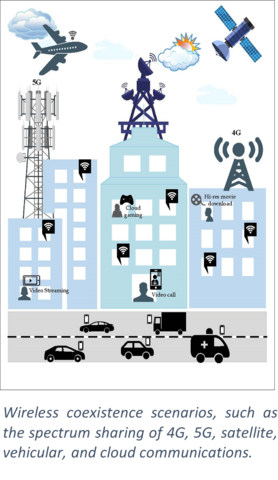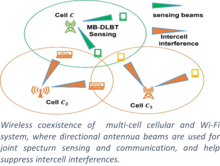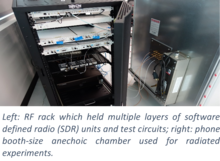Summary
This project aims to develop new modeling and measurement techniques of wireless coexistence systems to support the efficient use of the radio frequency (RF) spectrum and boost the development of new wireless services and applications. We research modeling methods for new spectrum-sharing scenarios, measurements to quantify wireless coexistence performance, and approaches to optimally configure and operate wireless communications systems.
We actively participate in the development of wireless standards, and contribute to or provide leadership for multiple industry-centric working groups in organizations such as ANSC C63, IEEE 1900.8, ATIS NextG Alliance, WInnForum, and others.
Description
What is Wireless Coexistence?

Wireless coexistence is the capability of multiple wireless devices and services in the same geographical area to access the same RF spectrum band simultaneously without causing harmful interference to each other. In other words, can they all operate successfully and maintain acceptable wireless performance?
Wireless coexistence involves licensed, unlicensed, and tiered-access spectrum scenarios. Examples of systems where coexistence is of interest include (but are not limited to): Wi-Fi, Bluetooth, licensed and unlicensed cellular services, internet-of-things (IoT), machine-to-machine (M2M) and medical device communications, and others.
A specific example of wireless coexistence is the tiered spectrum access in the recently-opened 6 GHz band where the unlicensed services, such as Wi-Fi 6E and listen-before-talk (LBT)-based 4G/5G systems share 1.2 GHz of the spectrum with the incumbent services (e.g., satellite uplink). The key to this sharing scenario is that the wireless systems do not cause harmful interference to the incumbent services.
Traditional electromagnetic compatibility or interference tests typically address the impact of one-way interference from one party to a victim party through unintentional emitters or receivers. Wireless coexistence testing addresses the mutual interactions and performance of all the involved intentional emitters and receivers.
Research Topics:
Due to the ever-increasing demands on wireless communications and limited radio spectrum resources, dynamic spectrum sharing has become a key solution to improving the ability of wireless communications systems to monitor, access, use, and share the RF spectrum. There is a strong need to develop standards and techniques for efficient sharing among systems and networks operating in licensed, unlicensed, license-assisted, or tiered-access frequency bands. Wireless coexistence research involves topics such as spectrum access management, spectrum sensing, interference protection of incumbent services, and system performance measurement and optimization, besides others.
Here, we view successful coexistence as a target that covers three aspects:
1. achieving (near)-an optimal performance that is bounded by communication and network theoretical limits;
2. efficiently and rigorously complying with spectrum sharing policies (e.g., those imposed by the government and standards bodies; and
3. fair sharing of spectrum use among services.
Our recent research activities include:

Topic 1: Provide system and frequency-agnostic modeling, simulation, and analytical techniques which address universal features of spectrum-sharing systems. We model the effects of system and policy constraints (such as incumbent protection), and other major factors such as interferences, protocols, and propagation channels. Furthermore, we aim to develop and apply advanced AI and machine learning (ML) methods that are explainable and trustworthy to optimize the system performance subject to policy and system constraints.

Topic 2: Develop cutting-edge spectrum test capabilities and procedures. These measurement methods can be used to quantify wireless coexistence, validate modeling and simulation results, and support the development of new theory. We utilize the National Broadband Interoperability Test Bed (NBIT), 5G Coexistence Testbeds, and software-defined radio (SDR) with in-house software programming for many of these measurements.
Topic 3: Develop new approaches to fairly share the spectrum constrained by policy or incumbent requirements. A current research focus is the decentralization of spectrum-sharing decisions, in which users fairly share the spectrum with each other through their own reinforcement learning-based decisions.
Topic 4: Develop intelligent spectrum sensing techniques which provide details of signal features, such as system technologies (4G LTE, 5G New Radio, and Wi-Fi), modulation and coding schemes, and other parameters to achieve RF spectrum awareness and support constructive coexistence. We aim to accomplish this by developing lightweight AI/ML algorithms to implement near real-time sensing.
Project Research in the News
- NIST Formula May Help 5G Wireless Networks Efficiently Share Communications Frequencies (additional information)
- Encouraging Coexistence: NIST Model Cuts Measurement Needs for Spectrum Sharing by About 33%
Workshops on Spectrum Sharing Topics that We have Organized:
- Workshop on Advancements in Spectrum Sharing (in IEEE Globecom 2019)
- Workshop on Spectrum Sharing Technology for Next Generation Communications (in IEEE ICC2021)
- The 2nd Workshop on Spectrum Sharing Technology for Next Generation Communications (weblink in IEEE ICC2022. See also NIST hosted webpage for more details and to download speakers’ and panelists’ presentations).

